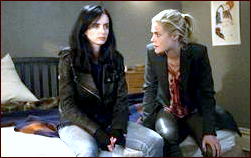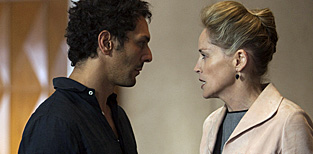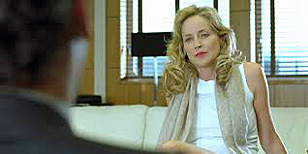Reviewed by DAVID VINEYARD:
CORTO MALTESE AND THE GILDED HOUSE OF SAMARKAND. StudioCanal, France, animated film, 2002. Original title: Corto Maltese: La maison dorée de Samarkand. Based on the graphic novel by Hugo Pratt. Richard Berry as Corto Maltese (voice), Patrick Bouchitey as Raspoutine (voice), Catherine Jacob as Marianne (voice). Directors: Richard Danto & Liam Saury.
Native: Ever since you whites came nothing has gone right for my people.
Corto Maltese: Every race has its specialty. That’s what we do best.
— “The Ballad of the Salt Sea”

Hugo Pratt is the Italian comic book industry, one of the most recognized and respected figures in Europe, and increasingly recognized here. He began his career with the super hero, the Ace of Spades and is best known for his long running western, Sgt. Kirk, about a white soldier living with the Indians and for Pyle, a war comic taken from the writings of Ernie Pyle. He is at once the Jack Kirby, Milton Caniff, Alex Raymond, and Harold Foster of the Italian comics.
Like many comic book artists and writers around the world, his greatest influence was Milton Caniff, his Terry and the Pirates and Steve Canyon. You can see the artistic influence in his drawing style and brushwork, but also in his storytelling techniques, at once cinematic and picaresque. This is truest of his greatest creation, the soldier (or should that be sailor) of fortune and Seven League booted protagonist of his most famous works, Corto Maltese.
But where Pat Ryan, Steve Canyon, Scorchy Smith, Smilin’ Jack, or even Frank Godwin’s Connie were straight shooting all-American heroes out of Hollywood central casting Corto Maltese is not.
In Corto Maltese, Pratt combined his interest in history, exotic but realistic locations, and adventure with his mordant humor, deep suspicions about the West and his own country’s Imperial past in colonization (this runs deep in Italian popular literature predating Mussolini’s ambitions, dating at least to Emilio Salagari’s tales of Malay pirate and anti imperialist Sandokan), and a protagonist out of Joseph Conrad as much as Terry and the Pirates. Corto would be more comfortable in the company of Lord Jim, Nostromo, or Conrad’s Captain Marlow than Pat Ryan, Connie, or Flip Cochran, though he would not be misplaced with the Dragon Lady or Burma, or for that matter the Spirit’s Sand Saref and P’Gell. He trips over more femme fatales than Philip Marlowe.

The closest thing I can find to compare this too would be Alvaro Mutis’s books Maqrol and The Adventures of Maqrol. There is no one in American or European comics or animation quite like Corto Maltese. He gives new meaning to unique.
The stories take place in the early Twentieth Century between the turn of the century and the 1920‘s encompassing the First World War, the Russo Japanese War, the massacre at Musa Dagh, the Irish troubles and countless other adventures in Southern Europe, Arabia, Africa, Russia, Manchuria, Ireland, and all points exotic, often told in relation to a search for treasure (Alexander’s gold, El Dorado, …).
Along the way Corto meets historical figures like T. E. Lawrence, Jack London, Mustapha Kemal, Enver Pasha, and his mad friend, Rasputin. Not to mention mysterious women ranging from orphans to seers from witches to murderous actresses to the queen of fairyland — as well as her husband Oberon, Puck, Merlin, and a talking raven. Things can easily get dreamlike and surreal in Corto’s fevered backwaters and he is always meeting mysterious women who don’t seem to be entirely of this world, however earthy their attractions.

He also runs into a wide range of natives, some good, some noble, some evil, some angry, in short, humans, not stereotypes.
Tall and dark in a peaked cap with Elvis side burns, and wearing the uniform of a ships captain of the era and with an earring in one ear, Maltese’s adventures are best read in the rich detailed color editions with Pratt’s otherworldly water colors. Not that the black and white isn’t just as startling. The animated series follows the rich water color look of Pratt’s work with extremely effective beauty. It is easily the most beautiful animated series I have ever seen.
The animated series has so far stayed close to Pratt in style and color scheme, and while the animation is limited, it is also rich and eye catching. I’m not sure I have seen anything quite like it outside of a feature film.

The Gilded House in Samarkand refers to a Turkish prison in Samarkand where Corto’s friend Rasputin is held. Gilded, because the only escape is through the Golden Dreams of opium enhanced sleep, well, for anyone but Rasp (Corto’s nickname for Rasputin).
And yes, Corto Maltese is the type of hero whose best friend is Rasputin, the mad monk.
You should know dreams play a great role in Corto Maltese’s adventures, fevered, drugged, from concussions, mushrooms; the mystery of the series tropical and other exotic locations are always part of the story.
T. E. Lawrence’s “Beware of those who dream in the daytime, for they will make their dreams come true,†might almost be an epigraph for all of Corto Maltese’s adventures.
In Samarkand, Corto is in Rhodes on the trail of the lost treasure of Alexander, stolen from Persia and Cyrus the Great. He is already in trouble as the story begins, mistaken for the traitorous Turk Chevet who is part of the Turkish schemes of Kemal and Enver Pasha to re unite Turkey after its collapse following allying itself with Germany in the first war. Not only do the Turks think he is Chevet, so do the Armenians seeking revenge against Chevet and Enver Pasha who was responsible for the Turkish genocide against the Armenians.

After stealing a map and evading both sides and the police Corto sails east for Samarkand to free his friend Rasputin and seek the treasure, but not before a seeress named Cassandra predicts a curious and enigmatic future for him.
Along the way he picks up an odd lot including a murderous sexually precocious actress who he rescues from the Turks in Tarsus, and is paid to escort a young Armenian girl. He will have a fevered opium dream he shares with his mad murderous friend Rasputin across great distances, hide out with whirling dervishes, get caught between the Russians and Turks at war in Samarkand, witness the death of Enver Pasha, dance in the streets with Rasputin, and in the cold heights of Kafiristan reach the cave where the treasure allegedly waits haven see the treacherous Chevet fall to the Russians like his master.
If you get the idea this is not a Saturday morning animated series and Corto Maltese is neither Terry and the Pirates or Indiana Jones, you are right.
Rasputin (having just escaped death with Corto at the hands of Chevet and Enver Pasha and dancing in the streets of Samarkand): Are we mad?
Corto: No, just happy, I think.

At times surreal, fevered, enigmatic, beautiful to look at, poetically written, maddening, and exciting, the Corto Maltese films are unlike any other animated series you have ever seen or likely will ever see. I’m not sure it is for everyone. It certainly isn’t Disney, but it isn’t Ralph Bakshi either. It is intelligent, intriguing, demanding, and enigmatic, like its laconic hero, and you may not be quite ready for animated characters with this much depth or animated stories this complex or ambiguous.
There are episodes available on YouTube in English — only half hour episodes though. The original Italian episodes offer full stories, or there are French language episodes of complete titles in multiple parts with English subtitles. Unless your Italian is good I recommend the latter, though you might want to dip your toes in with the English language episodes. Among the full serials available are The Gilded House in Samarkand, The Ballad of the Salt Sea, The Celtics, Under the Capricorn Sign, and Corto in Siberia (each runs about eighty minutes total). Whether they are available on DVD or not I don’t know, but they are certainly worth the effort to at least get a taste.
Saturday morning was never like this.
For that matter, nothing on American television and few movies were ever like this.


